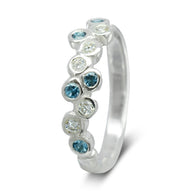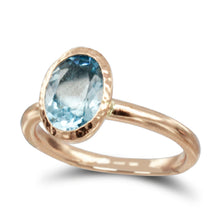Aquamarine in Jewellery is extremely versatile. The colour of an aquamarine tends to vary along the blue-green colour spectrum. Like emerald, aquamarine is a colour variety of the mineral beryl. The majority of aquamarines are of light blue colour, but the most expensive and coveted aquamarines are dark blue. Most aquamarine has a greenish blue colour, this is often heated to make it a more intense blue. With a hardness of 7.5 to 8 on the Mohs scale, it is a durable gemstone as long as it is treated with care to protect it against scratching and hard knocks. It can be found in a full range of different cuts from rough cut to cabochon or faceted shapes gemstones for setting or beads for stringing. It can also be carved. It’s hardness means it is ideal for giving a little colour to an engagement ring or eternity ring. Aquamarine is the birthstone for March and the gem of the 19th wedding anniversary.
Blue topaz or aquamarine?
We use both in our jewellery and it is very hard to differentiate between the two. By using a jewellers loupe you can tell the two gemstones apart. If you see two refraction lines when looking through a jewellers loupe at a gemstone you will know that it is, in fact, a blue topaz and not an aquamarine. A light blue topaz is a lot cheaper than an aquamarine, as it is widely available and usually has been irradiated to turn it from clear to blue. Aquamarines are usually natural, occassionally they will be heated to bring out a more intense blue colour but this should always be pointed out to you. As long as you are aware of what you are buying this gorgeous sea blue colour can be made available for most budgets.







Faceted rounds, ovals and pear shaped aquamarines. This fun collection of rings featuring aquamarines and diamonds set in platinum are versatile enough to use as an engagement ring, dress ring or eternity ring. we love the look of these smooth rubover settings framing these unusual gemstones.




Emerald cut, baguette and princess cut aquamarines are often featured in Art Deco style rings. Here are a few typically “stepped” designs inspired by this artistic era. We’ve slipped in a blue topaz to this row. Can you tell them apart?





Cabochons and rough cuts. Set in silver these lovely included aquamarines have the feel of the ocean about them. A cabochon often has a moonstone like quality to it. We love to aquire and use these giant pieces of natural art.






Colour combining. Aquamarines don’t just look good in the white precious metals of silver or platinum, it looks equally creative in rose gold or with a yellow metal highlight in these mixed metal fun dress rings and stacking rings. Its forgiving colour combines well with a variety of other gemstone colours. Our colour palette for our collections when it isn’t being pared with diamonds often combimes it with lime green peridot and purple amethyst or the dark blues of sapphire or tanzanite.
See more of our aquamarine in jewellery here



























